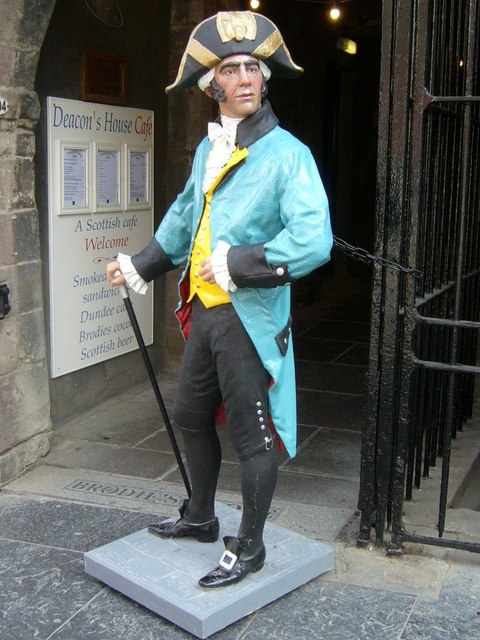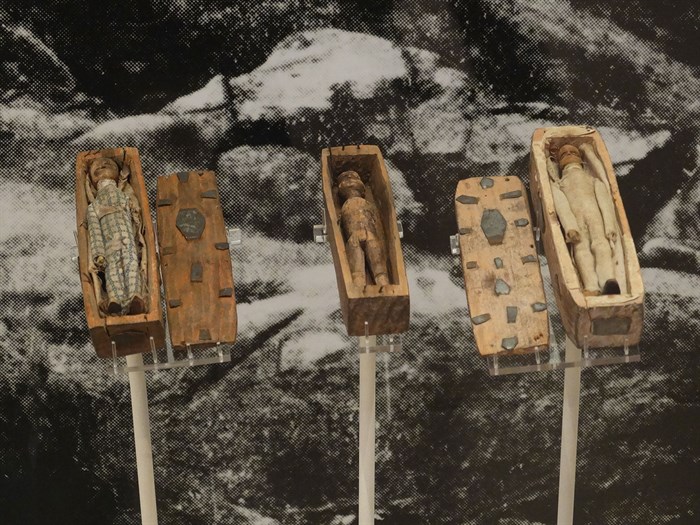Local Legends
Deacon Brodie
Deacon Brodie is one of Edinburgh’s most
infamous villains. A respected cabinet-maker
(furniture maker) with a well-to-do clientele in 1780s Edinburgh, Brodie turned to burglary to support a lavish lifestyle. He and his gang copied keys to public buildings and plundered them under cover of darkness. Brodie was caught, sentenced to death, and was hanged near St Giles Kirk on the Royal Mile.
The Writers’ Museum has on display a wardrobe made by Deacon Brodie and owned by Robert Louis Stevenson, who used Brodie as an inspiration for Dr Jekyll and Mr Hyde.
(furniture maker) with a well-to-do clientele in 1780s Edinburgh, Brodie turned to burglary to support a lavish lifestyle. He and his gang copied keys to public buildings and plundered them under cover of darkness. Brodie was caught, sentenced to death, and was hanged near St Giles Kirk on the Royal Mile.
The Writers’ Museum has on display a wardrobe made by Deacon Brodie and owned by Robert Louis Stevenson, who used Brodie as an inspiration for Dr Jekyll and Mr Hyde.
 |
| Figure of Deacon Brodie on Royal Mile |
Body-snatchers
The infamous ‘body-snatchers’ William Burke and William Hare terrorised Edinburgh,
carrying out a series of murders between 1827 and 1828. The bodies of
their 17 victims were sold to Dr Robert Knox, a private anatomy lecturer
in the City who needed specimens for his students to dissect.
When Burke and Hare were eventually found out, Hare testified against his friend, and was released. Burke was hanged for his crimes, before having his body publicly dissected at the Edinburgh Medical College.
When Burke and Hare were eventually found out, Hare testified against his friend, and was released. Burke was hanged for his crimes, before having his body publicly dissected at the Edinburgh Medical College.
The City Art Centre holds a series of engravings by an unknown
artist showing Burke, Hare, Knox, and some of the victims. These works,
and others in the collection, show the hold of these gruesome stories
over the public imagination.
Greyfriars Bobby
Greyfriars Bobby (1855-1872) was a Skye Terrier which became known in 19th-century Edinburgh
for spending 14 years guarding the grave of its owner until he died
himself.
The story continues to be well known in
Scotland, through several books and films. A prominent commemorative
statue and nearby graves are a tourist attraction.
Arthur's Seat miniature coffins
 |
| You can see them in the National Museum of Scotland in Edinburgh |
In a secluded spot on the north-east side of the hill, the boys discovered a small cave in the rock, hidden behind three pointed slabs of slate.
Concealed within were 17 miniature coffins called 'Liliputan Coffins'.
Eight of these coffins survive to the present day, and are on display in the National Museum of Scotland. Few objects in our collection excite as much intrigue. Who made the intricate carved figures? Who did they represent? Who placed them in their secret sepulchre… and why?
Almost 200 years after their discovery, we attempt to unravel the mystery of the miniature coffins.
Click here if you want to watch a video about this mysterious phenomena.
Withes Well
This site, situated at the entrance to the Castle esplande on the west wall of The Tartan Weaving Mill, is easy to miss.
A
cast iron wall fountain commemorates the place where over
three hundred women were burned at the stake accused of
being witches.
In
the 16th Century more witch burnings were carried out at
Castlehill than anywhere else in the country. The victims
often suffrered brutal torture before being put to death
at the stake. They were often nearly drowned by being 'douked'
in the Nor' Loch.
One of these victims, was Dame Euphane MacCalzean, accused of witchcraft for using a spell to sink a vessel out of Leith, and attempting to destroy the ship of King James VI as it entered North Berwick.
One of these victims, was Dame Euphane MacCalzean, accused of witchcraft for using a spell to sink a vessel out of Leith, and attempting to destroy the ship of King James VI as it entered North Berwick.
The Plaque Reads...
"This
Fountain, designed by John Duncan, R.S.A.
Is near the site on which many witches were burned at the stake. The wicked head and serene head signify that some used their exceptional knowledge for evil purposes while others were misunderstood and wished their kind nothing but good. The serpent has the dual significance of evil and wisdom. The Foxglove spray further emphasises the dual purpose of many common objects."
Is near the site on which many witches were burned at the stake. The wicked head and serene head signify that some used their exceptional knowledge for evil purposes while others were misunderstood and wished their kind nothing but good. The serpent has the dual significance of evil and wisdom. The Foxglove spray further emphasises the dual purpose of many common objects."







Brak komentarzy:
Prześlij komentarz